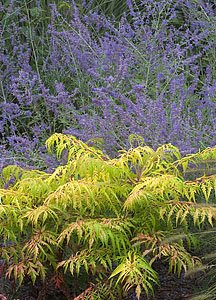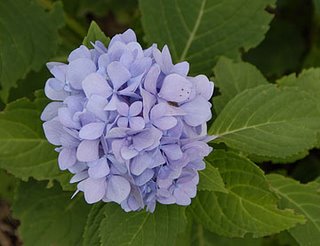 I notice that Tiger Eyes sumac, officially Rhus typhina 'Bailtiger' Tiger Eyes®, has been given a Gold Medal Plant Award for 2007 by the Pennsylvania Horticultural Society.
I notice that Tiger Eyes sumac, officially Rhus typhina 'Bailtiger' Tiger Eyes®, has been given a Gold Medal Plant Award for 2007 by the Pennsylvania Horticultural Society. I planted Tiger Eyes a couple of years ago in my front garden, amid ornamental grasses and Russian sage. It was an impulse buy at the nursery, one of those plants with such gorgeously colored leaves that it was simply irresistible.
My picture shows it in August when our Russian sage was in full bloom.
This sumac is supposed to stay relatively compact, growing about 6 feet tall and unlike other sumacs, it's said not to be invasive.
So far, that's true here in my Zone 5 garden. If my plant is anything to go by, it's a slow grower. Mind you, I planted it on a hill in full sun in one of the few sandy soil spots on our property – which is mostly clay – during a dry summer. It was all I could do to water it enough to keep it alive.
The shrub is still compact - just about 3 feet tall - after its second season, but I suspect that it might just take off and put on some height next year.
Here's the description of Tiger Eyes sumac from the PHS site:
"This unusual Sumac has purplish-pink stems displaying exotic cut-leaf foliage. Changing with each season, Tiger Eyes® starts out chartreuse in spring, turns bright yellow in summer, and blazes scarlet-orange in the fall. Tiger Eyes® is more compact than the species and is not considered invasive. It prefers well-drained soil but adapts well to poor soils and urban situations, exhibiting good pollution tolerance. Great for the foundation, as a specimen, in mass, or in containers, it grows about 6 feet high and wide in full or part-sun. Hardy in Zones 4 to 8."
For more information on the other PHS Gold Metal plants, click here.
Note: As this post is almost 4 years old, I will not publish any more comments or questions regarding about this topic here. If you have a question or comment, please use the contact form at my new blog.



